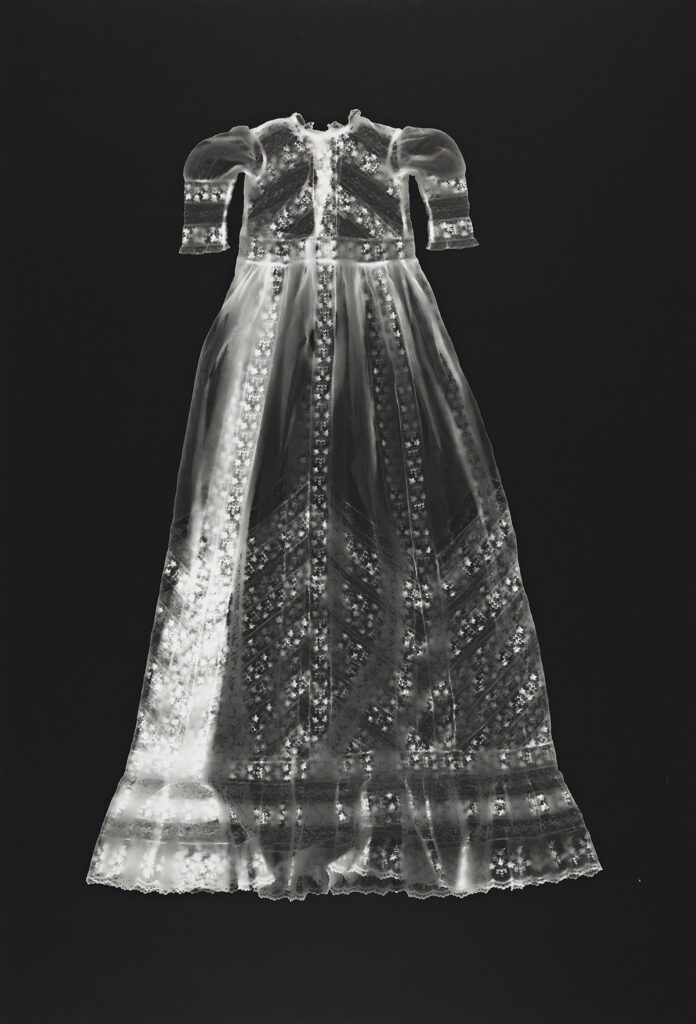Innovative Techniques and Early Influences
Adam Fuss is a British-born contemporary photographer known for his unconventional and innovative approach to the medium. Throughout his career, he has refined the cameraless technique, relying on the most essential elements of photography: objects, light, and light-sensitive material. Fuss’ work is distinctive for its contemporary reinterpretation of photography’s earliest techniques, such as the daguerreotype, which produces a single image, and the photogram, in which objects are placed directly on light-sensitive material and then exposed to light, creating ethereal and literal images. Adam Fuss was born in 1961 in London but grew up in Australia. In 1980, he began working as a photographic apprentice at the Ogilvy & Mather Agency. Two years later, he moved to New York City and began experimenting with a pinhole camera, through which he explored the use of historic techniques in photography. His early work was met with critical acclaim. Soon after, Fuss abandoned the camera and began breathing new life into a technique that became the hallmark of modernist photographers of the 1920s, such as László Moholy-Nagy and Man Ray.
Poetic Themes and Philosophical Insights
The work of Adam Fuss presents a poetic sense of detachment and wonder. Distilling the very essence of photography further emphasizes the themes of transformation and perception throughout his work. His subjects, which are often familiar such as water droplets, smoke, flowers, babies, christening gowns, and snakes, to name a few, become metaphysical and emotional in their association through stunning abstractions and compositions made with the earliest photographic techniques. The photograms of Adam Fuss often feel otherworldly and mysterious, as if they capture an alternative existence. His use of light and shadow, combined with his experimental techniques, creates a sense of ambiguity and suggests a reality beyond the visible world. When asked about his choice in using such early photographic techniques, he says,
“It’s only when I make a picture that I have to keep looking at that I feel I’ve succeeded. I’ve always needed to make images that have a sense of revelation to the viewer, namely me. It’s more like the sensation of looking into the face of someone very beautiful, or, perhaps, when… you’re faced with the unknown. I got into the pinhole and photograms because I was bored with the pictures I was seeing.”
Intimate Vision: Beyond Technical Information
For Fuss, the cameraless image is more intimate because it is made, not taken. Fuss says,
“I would much prefer people looked at my photographs as if they were paintings. Because when we look at paintings, we look only at the image; we experience it. Somehow, when people look at photographs, they want an answer to a question that they feel can be answered through technical information.”
And in return, his photography elicits a strong emotional response from viewers, evoking feelings of wonder, contemplation, and introspection. The ethereal quality of his images, combined with their intimate subject matter, creates a sense of intimacy and connection that transcends the physical realm.

Exploring Memory and Transcendence: “My Ghost'” Series
One of Adam Fuss’ most iconic series, ‘My Ghost,’ embodies his distinctive photographic style and thematic depth. He began the series in 1994, and it is considered one of Fuss’s most iconic and emotionally resonant bodies of work. Many larger in scale, the series includes spiritual associations realized in such images as christening gowns, smoke, and water. The photograph from the series presents a 19th-century child’s dress carefully laid out on photosensitive paper, which is then exposed to light. In its incredible ghostly nature, Fuss directs our thoughts to the wearer of the dress who is missing in the photograph, evoking themes of memory, life, loss, longing, and transcendence. The wearers of the christening gowns, infants, have their life ahead of them, symbolizing potential and transformation. During the creation of the image in his darkroom, which he refers to as “the shadow place,” Fuss contemplates profound questions:
“Is there a spiritual element in being alive? Is there a spiritual element to my past experiences?”
The gentle tonal gradation of the highlights as well as the exacting detail provide dimensionality and flow to the fabric, strengthening its visual effect. The play of light and shadow, the interplay of positive and negative space, and the juxtaposition of form and void create a sense of mystery and beauty that transcends the literal representation of the child’s dress.
Reinventing Photography: Materiality and Symbolism
Adam Fuss’s diverse body of work demonstrates his keen interest in the materiality of photography and the ways in which the medium can be manipulated and reinvented to create new visual experiences. By pushing the boundaries of traditional photographic processes and exploring themes of life, death, and the passage of time, Fuss has created a body of work that is both haunting and transcendent. His photographs are characterized by their dreamlike quality and their ability to evoke a sense of mystery and otherworldliness. His images often feature abstract forms, organic shapes, and symbolic motifs, inviting viewers to contemplate the deeper meanings and associations embedded within the visual compositions.
